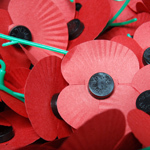What do we remember on Remembrance Day? Powerpoint
Item
Title
What do we remember on Remembrance Day? Powerpoint
See all items with this value
Abstract
This resource pack is designed to assist teachers to introduce specific themes into the classroom. Although primarily aimed at the History curriculum, it can also be used to support literacy and aspects of Citizenship, PSHE and RE. Geography and Maths activities are included.
Key Stage 2 History Coursepack
Teachersí Notes
What Are We Remembering on Remembrance Day?
Introduction: This course pack brings together resources from the First World War Poetry Digital Archive and the Great War Archive websites 1 produced by the University of Oxford for teachers of Key Stage 2 History.
Main URL: http://www.oucs.ox.ac.uk/ww1lit
Author: Alun Edwards, University of Oxford
Date: October 2009
Aim: To provide a set of images to explore Remembrance Day with relation to the First World War. Suggested activities are included for History, ICT, Citizenship etc.
Key Stage relevance: Year Group 2 History: Curriculum Area: Unit 17 What are we remembering on Remembrance Day?
This resource pack is designed to assist teachers to introduce specific themes into the classroom. Although primarily aimed at the History curriculum, it can also be used to support literacy and aspects of Citizenship, PSHE and RE. Geography and Maths activities are included. The pack should be used as a starting point for certain topics, or to inspire primary teachers to complementary routes on tackling these themes. The pack can be used to support the current areas of the National Curriculum2 for the following units:
* History - Key Stages 1 and 2, Units 9, 13, 17 and 20. Key Stage 3, The First and Second World Wars, including the Holocaust.
* Citizenship - Key stage 1-4: The identities behind Britain today. Understanding Human Rights. Challenging racism and discrimination. War, conflict and peace. Identity and diversity. Issues supporting rights and responsibilities.
* ICT
What is in the pack:
* PowerPoint presentation ñ Remembrance_Activities_Images.ppt [brings together all the images and links to other files, plus notes for teachers. N.B. In the ëNotesí for each slide (under PowerPoint go to VIEW > NORMAL) there are the suggested aims and activities you might cover.]
Additional resources suggested:
* Remembrance Day poppies
* Video showing present-day Remembrance Day commemorations in London and/or at a local war memorial (YouTube has some footage, and so does the website of the Royal British Legion)
* Video ëPeople of the Great Warí from the Imperial War Museum, created with teacher notes and intended for use in primary school assemblies etc., attached to certain versions of this resource pack but also available to download for free from http://www.iwm.org.uk/server/show/nav.22987
* Pictures, family memories or memorabilia from World War I or World War II recording local involvement, if applicable, e.g. photographs, postcards, medals, ration books
* There is a wealth of material freely-available to use for education on the website of the Great War Archive http://www.oucs.ox.ac.uk/ww1lit/gwa/
* The Education section of the First World War Poetry Digital Archive provides many similar activity and resource packs to assist with teaching the First World War http://www.oucs.ox.ac.uk/ww1lit/education/
* The Royal British Legion have produced a schoolsí remembrance pack which is free to download (in English and Welsh) from http://www.britishlegion.org.uk/remembrance/schools
* The BBC website ñ ë1918-2008 Ninety Years of Remembranceí has some useful ideas for teaching http://www.bbc.co.uk/remembrance
/see over for conditions of use
Conditions of Use
If using the images, audio, or film separately at all times you must include the statement 'This item is from The First World War Poetry Digital Archive, University of Oxford (www.oucs.ox.ac.uk/ww1lit); © [Copyright notice]'.
Anyone is entitled to use the material for Educational Purposes (means for the purpose of education, teaching, distance learning, private study and/or research) but not for Commercial Purposes (i.e. selling or reselling the material or using it for any commercial gain). Users may:
- copy items and save them;
- print the items;
- excerpt, annotate, aggregate and modify the items;
- use the items in virtual learning environments, managed learning environments and in any material to be used in the course of instruction. Course and study packs in non-electronic non-print perceptible form, such as Braille, may also be created;
- distribute, communicate and make available the items, to the public in any form and in any media whether now known or hereafter created as long as it is for educational non-commercial purposes;
- publicly display or publicly perform parts of the Licensed Work as part of a presentation at a seminar, conference, or workshop, or other such similar activity;
- deposit the items or parts in any kind or type of repository.
All the material presented here is made available under the JISC Model Licence and the HEFCE Licence for the digitisation projects running under the JISC Digitisation Programme Phase 2.
1 Funded by the JISC Digitisation Programme
2 Some text from the QCA/DfES scheme of work of the Department of Children, Schools and Families: History Key Stage 1 & 2 Unit 17 ëWhy is it important to remember?í Ref: QCA/00/489 © Qualifications and Curriculum Authority (QCA) 2000 http://www.standards.dfes.gov.uk/schemes2/history/his17/
---------------
------------------------------------------------------------
---------------
------------------------------------------------------------
Teachersí Notes
What Are We Remembering on Remembrance Day?
Introduction: This course pack brings together resources from the First World War Poetry Digital Archive and the Great War Archive websites 1 produced by the University of Oxford for teachers of Key Stage 2 History.
Main URL: http://www.oucs.ox.ac.uk/ww1lit
Author: Alun Edwards, University of Oxford
Date: October 2009
Aim: To provide a set of images to explore Remembrance Day with relation to the First World War. Suggested activities are included for History, ICT, Citizenship etc.
Key Stage relevance: Year Group 2 History: Curriculum Area: Unit 17 What are we remembering on Remembrance Day?
This resource pack is designed to assist teachers to introduce specific themes into the classroom. Although primarily aimed at the History curriculum, it can also be used to support literacy and aspects of Citizenship, PSHE and RE. Geography and Maths activities are included. The pack should be used as a starting point for certain topics, or to inspire primary teachers to complementary routes on tackling these themes. The pack can be used to support the current areas of the National Curriculum2 for the following units:
* History - Key Stages 1 and 2, Units 9, 13, 17 and 20. Key Stage 3, The First and Second World Wars, including the Holocaust.
* Citizenship - Key stage 1-4: The identities behind Britain today. Understanding Human Rights. Challenging racism and discrimination. War, conflict and peace. Identity and diversity. Issues supporting rights and responsibilities.
* ICT
What is in the pack:
* PowerPoint presentation ñ Remembrance_Activities_Images.ppt [brings together all the images and links to other files, plus notes for teachers. N.B. In the ëNotesí for each slide (under PowerPoint go to VIEW > NORMAL) there are the suggested aims and activities you might cover.]
Additional resources suggested:
* Remembrance Day poppies
* Video showing present-day Remembrance Day commemorations in London and/or at a local war memorial (YouTube has some footage, and so does the website of the Royal British Legion)
* Video ëPeople of the Great Warí from the Imperial War Museum, created with teacher notes and intended for use in primary school assemblies etc., attached to certain versions of this resource pack but also available to download for free from http://www.iwm.org.uk/server/show/nav.22987
* Pictures, family memories or memorabilia from World War I or World War II recording local involvement, if applicable, e.g. photographs, postcards, medals, ration books
* There is a wealth of material freely-available to use for education on the website of the Great War Archive http://www.oucs.ox.ac.uk/ww1lit/gwa/
* The Education section of the First World War Poetry Digital Archive provides many similar activity and resource packs to assist with teaching the First World War http://www.oucs.ox.ac.uk/ww1lit/education/
* The Royal British Legion have produced a schoolsí remembrance pack which is free to download (in English and Welsh) from http://www.britishlegion.org.uk/remembrance/schools
* The BBC website ñ ë1918-2008 Ninety Years of Remembranceí has some useful ideas for teaching http://www.bbc.co.uk/remembrance
/see over for conditions of use
Conditions of Use
If using the images, audio, or film separately at all times you must include the statement 'This item is from The First World War Poetry Digital Archive, University of Oxford (www.oucs.ox.ac.uk/ww1lit); © [Copyright notice]'.
Anyone is entitled to use the material for Educational Purposes (means for the purpose of education, teaching, distance learning, private study and/or research) but not for Commercial Purposes (i.e. selling or reselling the material or using it for any commercial gain). Users may:
- copy items and save them;
- print the items;
- excerpt, annotate, aggregate and modify the items;
- use the items in virtual learning environments, managed learning environments and in any material to be used in the course of instruction. Course and study packs in non-electronic non-print perceptible form, such as Braille, may also be created;
- distribute, communicate and make available the items, to the public in any form and in any media whether now known or hereafter created as long as it is for educational non-commercial purposes;
- publicly display or publicly perform parts of the Licensed Work as part of a presentation at a seminar, conference, or workshop, or other such similar activity;
- deposit the items or parts in any kind or type of repository.
All the material presented here is made available under the JISC Model Licence and the HEFCE Licence for the digitisation projects running under the JISC Digitisation Programme Phase 2.
1 Funded by the JISC Digitisation Programme
2 Some text from the QCA/DfES scheme of work of the Department of Children, Schools and Families: History Key Stage 1 & 2 Unit 17 ëWhy is it important to remember?í Ref: QCA/00/489 © Qualifications and Curriculum Authority (QCA) 2000 http://www.standards.dfes.gov.uk/schemes2/history/his17/
---------------
------------------------------------------------------------
---------------
------------------------------------------------------------
Audience
Level: Key Stage 1/2 History


